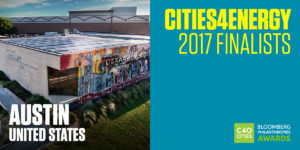Mayoral Roundtable Remarks
C40 North American Climate Summit
Tuesday, Dec. 5, 2017
 Addressing climate change through transportation policy in Austin is thinking globally but acting locally. Preserving our environment is a big priority in Austin. It’s huge. But most Austinites, stuck in rush hour traffic every day, will tell you traffic is the most immediate, in-your-face challenge.
Addressing climate change through transportation policy in Austin is thinking globally but acting locally. Preserving our environment is a big priority in Austin. It’s huge. But most Austinites, stuck in rush hour traffic every day, will tell you traffic is the most immediate, in-your-face challenge.
As big as that traffic challenge is, our climate protection goals are even bigger. We want to achieve net-zero community-wide greenhouse gas emissions by 2050. Getting there will require very directed and deliberate action. We’ve begun the process of closing our only coal plant and that will help. But we’re going to need to reduce our transportation carbon footprint if we’re going to make a big difference fighting climate change.
The good news is that we’re Austin so we’re willing to try almost anything. We’re hungry for ideas, and that feeds into one of our strengths. In some places, if it hasn’t been done before then there must have been a reason. “Keep Austin Weird” is our local identify. What’s weird to some is home to a bunch of people who are early adopters. Heck, in Austin kimchi fries are already old news. Being forward looking has had us looking to things like car-sharing, bike-sharing, and ride-hailing buses. Austin was the first North American city to get Car2Go, we helped develop the working business model for B-Cycle, Chariot’s mini-buses are refining its technology on our streets, and GM’s Maven is headquartered in Austin.
Let me give you an example of how comfortable Austin is with new things. Back in 2015, Waymo – the Google automated car company – a blind passenger sat in a car that drove him, by himself, to the doctor. It was an historical first: a fully autonomous trip under normal conditions in normal traffic. Austin is the Kitty Hawk of autonomous vehicles. In fact, those driverless cars have been using our streets as testing grounds for a couple years.
We’re leveraging our position on driverless cars by preparing the way for electric automated cars. We’re building charging stations all over town, moving toward electrification of our city fleets, and on our city’s new Electric Way, stations charge cars and phones in a way that helps us develop a Smart Mobility Roadmap.
We’ve seen success on rapid buses, so we’re developing a comprehensive plan that reroutes our existing fleet to increase ridership and gives buses free access to just newly opened managed lanes on highways – all while using bike-sharing and multi-passenger ridesharing for first- and last-mile solutions.
We noticed that 20% of our downtown traffic can be cars driving around looking for parking, so we’re testing new parking technologies at this upcoming Spring’s SXSW festival. One App-based system will inventory downtown parking spaces (including street, structured, and even consigned private parking) and allow people to reserve a space before they come downtown and then drive right to it.
We’re managing demand by accurately recognizing the cost of parking and dynamically pricing toll lanes, paid for by automobiles and free for transit.
We’re using data better in partnership with the University of Texas, the Texas Transportation Institute and the Southwest Research Institute – creating a new research triangle, based this time on mobility innovations.
The lessons we’re learning are clear: Where we offer multiple, diverse transportation options, Austinites get out of their cars and ride bikes, take buses, and even walk. Where we don’t offer those choices – where we don’t have protected bike lanes, frequent bus service, even sidewalks – people stay in their cars. Our challenge is to expand choices.
We’re re-writing our 30-year old land development code to integrate planning and development of our built environment to better support and integrate how we live with how we best move around.
And we’re acting strategically and regionally. In ways never done before, all of Central Texas is aligning newly developing regional planning, city and county planning, and transit agency planning. We’re even working with San Antonio to the south, including developing new transit options, as we look ahead to Texas’ next great metroplex.
New ideas are not going to be enough. We’re going to have to level up to expand these options. We just recently passed the biggest mobility bond in city history. It was bigger in fact than all the mobility bonds in the previous 20 years added together. And it passed with 60 percent of the vote. Most of this bond was not about just pouring concrete. We’re making better use of our existing roads, making them more efficient and safer. We’re putting scores of millions of dollars into active transportation; bikes, trails, and sidewalks.
But we look enviously at cities like Los Angeles, Seattle and Phoenix which are teeing up regional transportation plans that will cost billions (and we’re wishing Nashville the best of luck with their upcoming financing election). Austin may be headed in the right direction, but the scale of our thinking does not yet meet the scale of our challenges.
That’s our next challenge, to scale up our ambition. We have the need and the support in the community to go big on mobility in ways that will benefit both our mobility and our climate. We know our future is dependent on both and we find that, to an ever-increasing degree, that they are wonderfully aligned.

2 comments
Comments are closed.